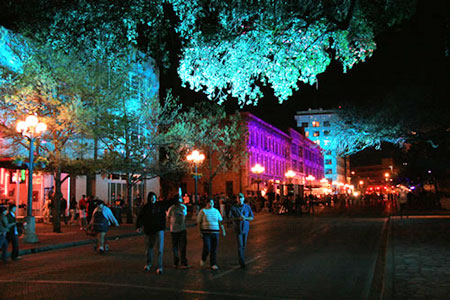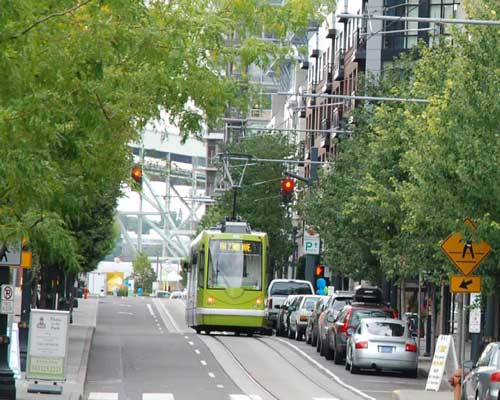WTF? Oh, it’s a FYA!

“What the heck is that?!”
That seems to be a common reaction of local motorists as they first encounter one of the flashing yellow arrow (FYA) traffic signals that have popped-up at San Antonio intersections over the past year or so. What began as an experiment in late 2008 at a couple dozen intersections along Wurzbach Rd. and San Pedro Ave. has now spread to about 40 or so intersections across the city and will now become a standard, not just here in San Antonio, but nationally as mandated by the federal Manual on Uniform Traffic Control Devices (MUTCD). As often happens in these cases, there has been some second-guessing amongst the general public as to the necessity of this newfangled signal, but understanding the research that went into it and why it’s beneficial generally allays those knee-jerk criticisms.
Automobiles Bicycles Commuting Roads Toll roads Transit Travel
by Hugh
Comments Off on 2005 Dodge Caravan 4th anniversary
2005 Dodge Caravan 4th anniversary
This is somewhat obscure but while searching through papers for the upcoming tax adventure, I happened upon the original sales document for my 2005 Dodge Caravan which I purchased exactly four years ago to the day, March 28, 2006. Since then I have added 69,271 miles to its already high one year total of 28,702 – it was probably a rental that maxed out early – making a grand total, as of today, of 97,973. more »
INRIX: Congestion in SA slightly worse
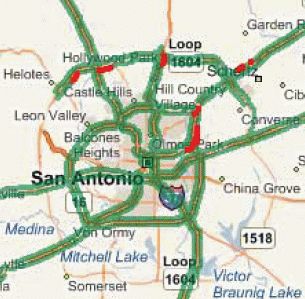
Top 10 SA-area bottlenecks (in red)
Traffic data services company INRIX’s annual “National Traffic Scorecard” was released a few weeks ago, and it shows that traffic congestion in San Antonio increased slightly over the past year.
This year, San Antonio ranked 25th in the nation in terms of overall traffic congestion. After flip-flopping with Houston last year, the Dallas-Ft. Worth area regained the title as Texas’ most congested region, landing at the number five spot nationally. Houston was sixth, and Austin was 23rd. The Los Angeles area was tops.
New traffic sign needed: “Take turns”
Someone sent me this and I thought it was interesting enough to post here. It’s about four and a half minutes long and worth a look.
Fifty percent of traffic accidents happen at intersections. Gary Lauder, who is the managing partner of Lauder Partners, a venture capital firm, and the co-creator of the Socrates Society at the Aspen Institute, shares a brilliant and cheap idea for helping drivers move along smoothly: a new traffic sign that combines the properties of “Stop” and “Yield” — and asks drivers to be polite.
Construction and closures Roads Transit: downtown
by Patrick
Comments Off on Downtown will be jam-packed Saturday
Downtown will be jam-packed Saturday
It’s going to get a little crazy this Saturday, with some 200,000 or more people converging on downtown and carrying on from morning to night.
If you’re heading down there, or just passing through, have a plan. Several streets will be closed. And buses on a dozen routes will be rerouted throughout the day.
First up, an annual St. Patrick’s Day Parade will thump and blast its way past the Alamo, starting at 11 a.m. Then the party will shift to the River Walk for an afternoon of dancing and music at the Arneson River Theatre and a 3 p.m. river parade.
Later, throngs of artists, performers, musicians and fans will light up La Villita and HemisFair Park for Luminaria: Arts Night in San Antonio, and hang out past midnight. The celebration highlights Contemporary Art Month.
So if you want to be mobile in downtown San Antonio this Saturday, you might have to get a little creative. Good luck!
More on:
Automobiles History Roads Travel
by Hugh
Comments Off on On the road to Bigfoot, Texas
On the road to Bigfoot, Texas
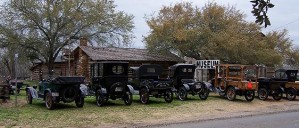
T Fords of Texas at the Bigfoot museum
Last Saturday, March 6, I had the great pleasure of taking part in a “T Fords of Texas” club cruise around Medina County. Led by Castroville residents Tom Campbell and Wayne McBryde, a group of nine Ts traversed the area’s handsome back roads under a glowering sky, dense with dark and darker grey clouds, too high to actually rain, but very dramatic. In an open runabout T driven by Gary Bethke, I had the full opportunity to take in the wintry landscape with occasional hints of spring, such as isolated peach and red bud trees in delightfully unexpected full bloom.
Commuting Construction and closures History Roads Transit Uncategorized
by Hugh
1 comment
The only thing to look forward to is the past
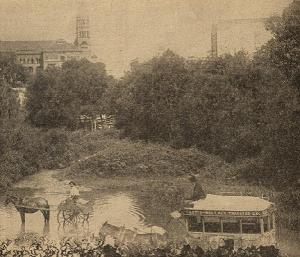
Omnibus soaking its wheels in the SA river
With all the zippidy-doo-dah hoopla over the possibility of a return to streetcars, why not go the whole hog and bring back mule drawn omnibuses? I mean, who else is doing that? Let’s think outside the box and get out of Portland, Oregon’s shadow once and for all. Think of the benefits. No expensive overhead or the need to tear up streets for miles on end and tourists will love it.
Mule drawn streetcars were introduced in San Antonio in 1878 but omnibus service has that beat by seven years. It cost 5 cents to go from Main Square to Alamo Plaza. With all the money we’ll save by not installing staggeringly expensive streetcar systems and their unsightly overhead power lines, we could go back and charge the same fare in 2010 that it was in 1871. I guess there is a flaw in my logic somewhere but, you know, I’ll be d****d if I know what it is.
Commuting Passenger rail Roads Toll roads Transit: Broadway South Alamo Street streetcars U.S. 281
by Patrick
Comments Off on Streetcar dreams: Now it’s time to talk money
Streetcar dreams: Now it’s time to talk money
After starting the fiscal year by shaving $19 million in spending, including 330 jobs, the city is now being asked to kick in $17 million to build a two-mile streetcar line.
That’s just part of the bill to buy streetcars and lay rails along Broadway and South Alamo Street by 2014. The county, VIA Metropolitan Transit and the federal government could also pony up to help pay what would be an estimated $90 million.
City Council heard the pitch this afternoon.
“If there was any sticker shock … council members mostly kept it to themselves,” the Express-News wrote.
The city hasn’t made any commitments, at least not yet.
At $45 million a mile, the price tag is quite a bit cheaper than, say, turning U.S. 281 out by Stone Oak into a superhighway, or, I should say, tollway.
Ah, but already I’m talking apples and oranges. This quaint two-mile rail line wouldn’t be a wide commuter route helping connect San Antonio’s core to its fringes.
Nope, unlike U.S. 281’s role as an artery for sprawl, the rail line, if done well, would be a magnet for compact living, working and playing. The idea is to drive some growth to the inner city, by creating a place where people would gladly leave their cars behind more often. Tourists would love it too.
Nonetheless, critics and proponents will duke it out with such comparisons. And with so many angles on varying public and private costs, some visible and some not so visible, expect a debate that’s about as clear as mud.
Docs and links:
